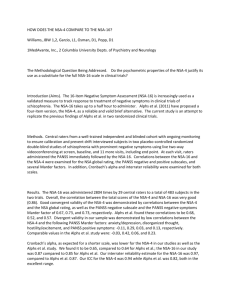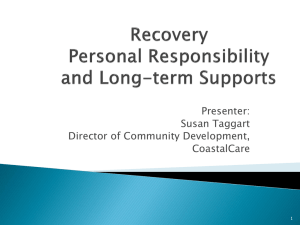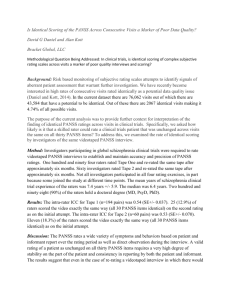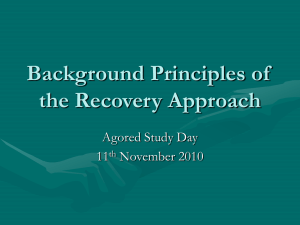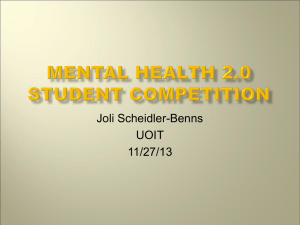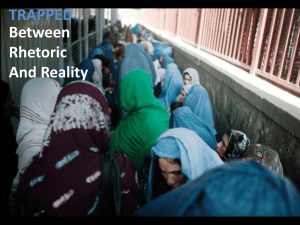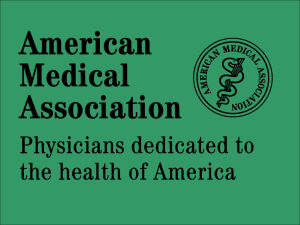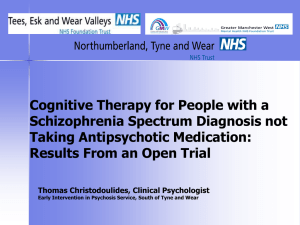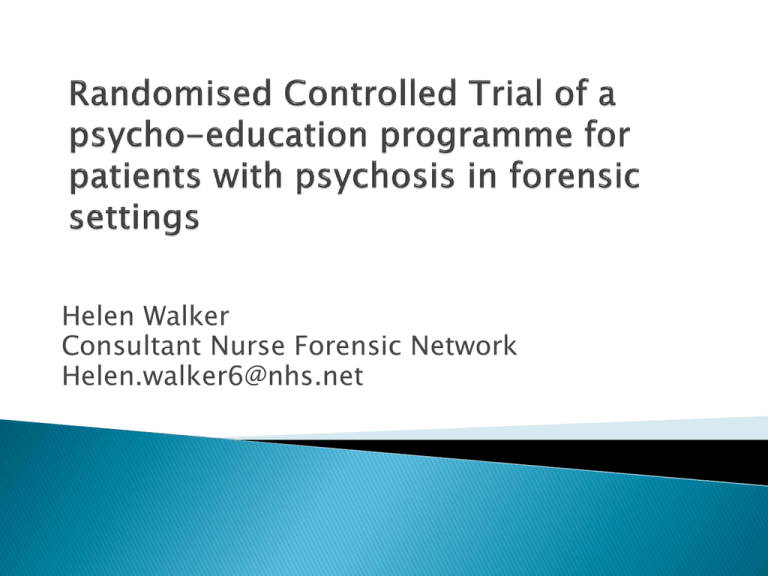
Helen Walker
Consultant Nurse Forensic Network
Helen.walker6@nhs.net
Introduction to psycho-education
Describe research project
Present a summary of key findings for Part 1
and Part 2
Draw conclusions and make
recommendations
Research Assistant
The State Hospital-Lindsay Tulloch
Principal Investigators
The State Hospital – Alan Steele
Orchard Clinic – Mark Ramm
Rowanbank Clinic & Leverndale Hospital –
Dr Emma Drysdale
Clinical Advisor
The State Hospital - Dr Gary MacPherson
Funded by The State Hospital
Supervised by Professor Colin Martin at The
University of the West of Scotland
Psycho-education for psychosis has been
developed to explain illness and treatment to
people with psychosis, in order to enable
them to cope more effectively with their
illness Favrod et al (2011).
Up to 1980s
Relapse and re-hospitalisation
(Neuman and Fuenning 1977)
Compliance with medication
(Roccella 1976)
Knowledge gain (Gillum, 1974,
Goldman and Quinn 1988)
Post 1990s
Relapse and re-hospitalisation
(Auguglia 2007, Lincoln 2007, RummelKluge 2008, Xia et al 2011)
Compliance with medication
(Cunningham Owens 2001)
Symptomatology (Pekkala 2002)
Insight (Merinder 1999)
Knowledge gain (Jones 2001, Jennings
2002, Sibitz 2007)
Quality of life (Cross 2002, Bauml 2007)
Social functioning (Atkinson & Coia
1996)
Patient satisfaction (Merinder 1999,
Aho-Mustonen 2011)
11 week group programme
Foundation: understanding
mental illness and
personality disorder, Stigma
and myths, Looking at
‘symptoms’ of psychosis,
what caused my illness
The Legal System: risk
assessment and risk
planning, legal issues
around admission and
discharge
Coping skills and recovery:
relapse and early warning
signs, problem solving
PSYCHOEDUCATION
PROGRAMME
CLINICIAN’S MANUAL
&
PARTICIPANT’S MANUAL
Aim: Evaluate the effectiveness of a psychoeducation programme (Coping With Mental
Illness) in a population of mentally disordered
offenders with psychosis and capture therapeutic
change
Part 1: Multi-site Randomised Controlled Trial
(cluster trial): The State Hospital (high), Orchard
Clinic (med), Rowanbank (med) and Leverndale
(low)
Part 2: Structured interview using Repertory Grid
technique across two sites (TSH and OC)
The RCT will establish what might change for the
individuals concerned and the interviews will
explore why this has occurred.
Participants referred by multi-disciplinary team
When adequate numbers were available, patients
randomly allocated to either treatment or control
(waiting list) group by Principle Investigator (PI)
at each site
Sealed envelope was issued to each (PI) at the
outset with computer generated numbers for
allocation-this was undertaken by UWS
Chief Investigator and Research Assistant were
blind to allocation
Assessments undertaken at three stages, pre
intervention, post intervention and six month
follow up, over 3 ½ year period
Clinician rated
Schedule for the
Assessment of Insight
[SAI](David 1990)
Positive and Negative
Syndrome Scale
[PANSS](Kay 1987)
Calgary Depression Scale
for Schizophrenia [CDSS]
(Addington 1993)
Behavioural Status Index
[BEST-Index] (Woods and
Reed 2000)
Self rated
Forensic Assessment of
Knowledge Tool (Walker 2012)
Assessment of Insight
(Markova 2003)
Rosenberg Self Esteem
Inventory (Rosenberg1965)
Locus of Control (Jomeen
2005)
Liverpool University
Neuroleptic Side Effect Rating
Scale [LUNSERS] (Day 1995)
Schizophrenia Quality of Life
Scale-Revision 4 [SQLSR4](Martin 2007)
Hospital Anxiety and
Depression Scale(Snaith 1994)
Patient satisfaction
Demographic details : descriptive statistics
Analysis of Variance (ANOVA) and Analysis of
Covariance (ANCOVA) where appropriate
IQ was the covariate -because there was a
statistically significant difference in baseline
scores between treatment and control groups
Also significant difference between groups in
age of illness onset and age of first
conviction
Non-parametric tests used where data was
ordinal level or not normally distributed
Registered as eligible
participants (N= 107 )
Not randomised (n= 26 )
Reasons: no patient consent (5), staff resources (3), took ill (2), died (1),
decided to do 1:1 treatment (2), errors in randomisation process (n=13)
Randomised (n= 81)
Received treatment as usual
(TAU) as allocated (n = 35)
Did not receive treatment as
usual as allocated (n = 0)
Received intervention
(experimental group) as
allocated (n = 46)
Did not receive intervention
as allocated (n = 0)
Completed post TAU (n = 35)
Did not complete post TAU
(n = 0)
Completed post intervention
(n = 46)
Did not complete post
intervention (n = 0)
Crossed over to become
experimental participants at
this stage – therefore unable to
do six month assessment
Completed 6 month follow up
(n = 30 )
Did not complete 6 month
follow up (n= 6)
Moved outwith area (n = 10)
Completed trial (n= 35)
Completed trial (n= 30)
Hospital Site
Male
Female
Total
The State
Hospital
Rowanbank
Clinic
35
0
35
8
1
9
The Orchard
Clinic
24
1
25
Leverndale
Hospital
12
0
12
79
2
81
Age: range 19-57, mean 37 years (sd 9.39).
Ethnic origin: (n=75) were of White British or Irish origin,
(n=2) Black/Black African, (n=1) Asian
Bangladeshi,(n=1)Chinese and (n=2) of other mixed
background.
44% of the sample originated from the West of Scotland.
Marital status: majority single (n=60), only (n=1) was
married, (n=20) were divorced, separated or widowed.
Employment status: prior to admission (n=76) were
unemployed. Only two participants were involved in
professional trades, one was an apprentice and one was a
student, (n=15) had never been employed in their life.
Most educated
in mainstream
schools
(n=74), only
one participant
had no formal
education,
seven had
behavioural
problems and
had special
schooling
Index offence
No offence (n=30)
Serious assault, murder,
attempted murder,
culpable homicide
(n=38)
Sexual related offences
(n=3)
Other (n=10)
History of drug (n=64) and
or alcohol misuse (n= 68)
On most occasions it was
not known whether this was
linked to the index offence
or not.
Although over half of the
participants had never
entered high secure
hospital prior to the current
admission, (n=32) had
multiple re-admissions.
Comparison of treatment versus control group scores pre
and post group (ANCOVA)
Assessment tools
Treatment
Mean
Control
Mean
FAKT pre
30
29
FAKT post
36
29
SAI pre
10.9
10.6
SAI post
12.2
10.7
PANSS +ve pre
13.8
14.6
PANSS +ve post
12.4
14.3
PANSS –ve pre
16.7
17.5
PANSS –ve post
15.2
17.9
BEST-Index
empathy pre
100
100
BEST-Index
empathy post
109
103
F
Level of
significance
9.45
p=.003*
2.34
p=.13
1.92
p=.17
1.22
P=.17
4.965
p = .029*
Assessment
tools
Treatment Treatment Treatment Level of
significance
Mean pre Mean post Mean 6
month Fup
SQLS-R4
36
HADS Anxiety
7.5
HADS
Depression
30
29
p=.475
6
5.9
p=.989
5.1
4.4
3.6
p=.601
Rosenberg
18
19
20
p=.835
BEST-Index
(total score)
563
572
559
p=.417
MHLC-C
63
64
62
p=.526
LUNSERS
28
23
24
p=.845
Assessment tools
Level of significance
CALGARY
Kruskal-Wallis Test
1.121
p=.290
Insight Scale
Chi-square (χ 2)
24.78
p=.16
Paired Differences pre and post intervention
95% Confidence Interval of
the Difference
SAI
FAKT
Std.
Std. Error
Deviation
Mean
Mean
-1.254
3.555
.463
Lower
-2.181
Upper
t
-.328 -2.710
df
58
Sig. (2tailed)
.009
-3.319 -5.332
56
.000
-5.316
7.527
.997
-7.313
-.579
4.656
.617
-1.814
.656
-.939
56
.352
PANSS positive
.847
3.398
.442
-.038
1.733
1.916
58
.060
PANSS negative
1.288
4.764
.620
.047
2.530
2.077
58
.042
HADS anxiety
.614
4.754
.630
-.647
1.875
.975
56
.334
HADS depression
.404
3.122
.413
-.425
1.232
.976
56
.333
-.965
10.712
1.419
-3.807
1.877
-.680
56
.499
-7.052
20.735
2.723
-12.504
-1.600 -2.590
57
.012
SQLS-R4
3.947
14.785
1.958
.024
7.870
2.016
56
.049
LUNSERS
2.772
16.893
2.237
-1.710
7.254
1.239
56
.221
Rosenberg
MHLC-C
BEST-Index (total)
George Kelly (1905-1967)
American Psychologist,
developed a theory of
personality
Personal Construct
Psychology (PCP)
Capture patient perspective.
PSI is based within the person-centred tradition.
Person-centred theory starts from a process theory of
authenticity, not from a theory of disorders (Schmid,
2006).
All participants bring with them their own ideas,
experiences and opinions.
Patients should be acknowledged as experts in their own
experiences; recent advances in understanding mental illness
and psychotic experiences (The British Psychological Society,
2000).
Kingdon & Turkington (2005) report, “Individualising psychoeducation helps people feel listened to and understood, and
this approach adds to its effectiveness”.
In essence, PCT is a theory about how people make sense of
the world around them.
Personal construct psychology (PCP) describes the way in
which this theory applies to an individual, based on the
following underlying principles:
The explanation for any individual’s behaviour lies within that
individual.
People are active in the world and not passive recipients of
events going on around them.
Change is always possible – no one is the victim of their own
history.
The four key concepts which are important in understanding
PCP are: the process of construing, people as ‘active
scientists’, constructive alternativism and PCP as a universal
theory.
Construing refers to how people interpret events, and
constructs are personal discriminations that individuals make
between people, events or situations (Houston 1998).
Construing is not the same as thinking because it involves the
notion of contrast, and of making an active interpretation or
discrimination.
Example: if a person described herself and her mother
reliable, in direct contrast to her brother, then the
discrimination ‘reliable versus not reliable’, is a construct
which the person uses. This construct contributes to their
view of the world, i.e. it is part of their construct system.
A number of studies have been undertaken with a different
focus:
mental illness and offending (Norris 1977, Goold 1998)
alcohol, drugs and offending (Blackburn 1993),
sex offenders (Marshall and Barbaree 1990b),
young offenders and delinquency (Stanley 1983, Viney 2002),
violence and aggression (McCoy 1981, Blackburn 1993)
personality disordered offenders (Blackburn 1990, Dolan
1995).
1
How I was 10
years ago
How I am
now
How my
Dr sees me
How I would
like to be (ideal
self)
How I expect
to be
(expected
self)
7
Have hope to
move on
Have no sense of
hope to move on
Have confidence
to engage in
groups
Negative feelings
about groups
Understand my
own illness and
how it affects me
Have no
understanding of
what illness is all
about
Don’t realise
others have the
same problems
Realise that others
have the same
problems
Realise I am a
valuable person
in society
Think I am
worthless
Have little or no
control over how
I think and feel
Have control of my
illness
Feel normal
Don’t feel normal
Grid Suite (Fromm
2011)
Cluster Analysis using
dendograms
Principal Component
Analysis
Elements are indicated by red dots and positive / negative constructs by green dots.
Dave was born in the West of Scotland, dual diagnosis of
paranoid psychosis and anti-social personality disorder and
has been a patient in a high secure hospital for 2 years,
following the attempted murder of his uncle. Aged 31, Dave
is white, single and was unemployed prior to his admission,
his IQ is in the low average category (80-89) and he has a
history of both drug and alcohol misuse since his early teens.
During the initial interview, undertaken prior to attendance at
the group, Dave was particularly anxious about a pending
court appearance and was very unsure as to whether his
‘head was in the right place’ for doing the group. By his own
admission he was ‘feeling low’ and was worried about the
potential success of his appeal to a lower level of security. He
thought the group might ‘be no more than a useful
distraction at this point in time’ but did state he was ‘keen to
learn more about psychosis and how it affects you’.
“Before the programme, I felt that people I
didn’t like and those I admired saw me and
my future negatively. I felt that I wanted to
be and expected to be how I was ten years
ago, even though at that time I had little
control over my illness. I felt that a person I
didn’t like saw me before the programme as
not being able to do stuff without being
annoyed and having little control over my
illness”.
•SAI score (16) higher than the group as a whole (mean = 10, standard
deviation (sd) 5.2, n=18).
•FAKT was poor (13) lower than the rest of the group (mean=29, sd=9.3,
n=18).
•Self esteem (14), lower than group average (mean=19, sd=5.8, n=18) would
fall into the category of ‘low self esteem’.
•Locus of Control (MHQL) low (40), by comparison to a group average of
(mean=61, sd=12.6, n=18).
• HADS (10) depression scale (mean=5, sd=4.2, n=18) and 14 on HADS
anxiety (mean=7, sd=5.2, n=18)
•CDSS (8 )(mean=2, sd=4.S, n=18) - higher than group average.
•PANSS +ve symptom (13) (mean=14, sd=5.1, n=18)
•PANSS -ve symptom score (25) (mean=17.5, sd=7.1, n=18) and general 32
(mean=29, sd=8.6, n=18).
“Having confidence to engage with the group helped me to
feel hopeful to move on. I felt more normal and that I could
be a valuable person in society”.
There is evidence to suggest that Dave has accepted his past
self maybe wasn’t as idealistic as he initially thought and
that there are ‘areas of life that will need to change’, if a
successful future is what is wanted. A clear example of this
is his drug use. Dave was ‘getting by’ through regular use of
‘hash, amongst other things’ and a few members of his
family actively encouraged this, indeed it seemed to be the
norm for both family and many of his closest friends. He was
able to identify the links between the effect of drugs on his
anti-social behaviour and the deterioration in his mental
state, causing an increase in paranoid ideation.
Insight improved to (17) post intervention, again higher than
the group (mean = 11, (sd) 5.1, n=18).
Knowledge of illness much improved at (32) and on a par with
others (mean=32, sd=9.5, n=18).
Self esteem improved slightly (15) - still lower than the group
average (mean=19, sd=5.8, n=18)- but on the threshold of
low self esteem.
Locus of Control increased to (48), group average of
(mean=62, sd=11.3, n=18).
Dave improved on both HADS sub-scales, (9) on the HADS
depression scale (mean=4.8, sd=4.7, n=18) and (12) on the
HADS anxiety (mean=6.5, sd=5.7, n=18), both within normal
range.
CDSS score lowered to (5) (mean=1.9, sd=4, n=18), still
higher than the group average.
PANSS =ve symptom score improved lowering to (12)
(mean=13.4, sd=5.3, n=18), -ve symptom score was also
slightly better (23) (mean=16.4, sd=6.7, n=18) and general
remained the same (32) (mean=29, sd=8.5, n=18).
Advantages
Improved knowledge
Trend indicating improved
insight, mental health,
social behaviour and quality
of life
Patients like it
Established programme
protocol driven
Meets low secure care
standard
Meets low intensity
intervention criteria for
Scottish Government HEAT
target
PSYCHOEDUCATION
PROGRAMME
CLINICIAN’S MANUAL
&
PARTICIPANT’S MANUAL
Difficulties associated with randomisation
had impact on results
Sample size too small to allow many of the
psychometrics to reach significance, reducing
generalisability beyond forensic context
Suggest this programme – which has
demonstrable benefits to the target
population – is utilised in clinical practice,
across the forensic network, in its current or
a (recognisable) modified form.

